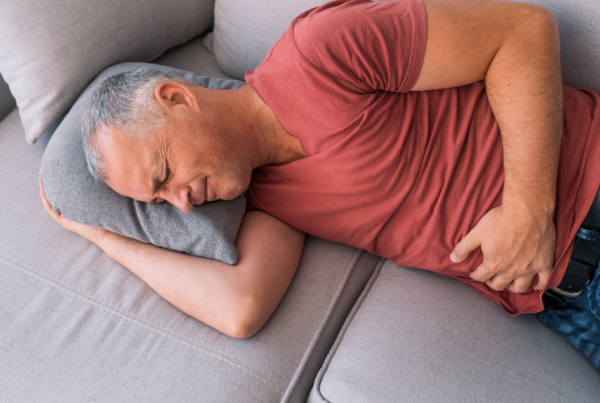Pelvic Girdle Pain
Move Better. Live Fuller. Your Wellness Journey Starts Here.
Schedule a FREE Discovery Call!
What Is Pelvic Girdle Pain?
Pelvic girdle pain (PGP) is pain felt in or near the pelvic region that is caused by inflammation, instability, or other problems with the pelvic girdle.
The pelvic girdle is a bony structure that connects the lower limbs to the axial skeleton (the core portion of your skeleton that contains the bones of your head, neck, ribs, and spine). The pelvic girdle contains bones, muscles, and ligaments that make up your hips, hip joints, sacrum, and tailbone.
It is an important weight-bearing structure that supports your upper body and transfers your body’s weight accordingly when switching from sitting to standing and vice versa. It provides important attachment areas that allow for movement and posture, and provides the body with stability. It also protects your pelvic organs!

When an individual experiences pelvic girdle pain, it can be felt in the front or back of the pelvis, as well as the lower back, hips, thighs, or other nearby areas. It can make mobility difficult, and significantly impact your quality of life. Walking, moving from sitting to standing, or getting out of bed may be more difficult. Other symptoms that can occur with PGP include:
- Knee pain
- Clicking sounds in the pelvic area
- Irregular gait
- Difficulty climbing stairs
- Pain when lying down
- Pain or difficulty with motions such as getting out of bed, the bath, or vehicles (swinging the leg)
- Pain with sex
- Pain in the perineum
- Difficulty standing or walking for long periods
Pelvic girdle pain is commonly mistaken as low back pain since the sensation of pain in both scenarios can be similar, but the cause of the pain as well as the actual location of the pain differs. Pain can also occur in both areas at the same time.
What Causes Pelvic Girdle Pain?
Pelvic girdle pain can be felt regardless of sex, and is more common in those who are pregnant or postpartum. Pelvic girdle pain is often caused by pregnancy due to the bodily changes that add more pressure onto the pelvic girdle. The growing weight that occurs during pregnancy affects the tilts and posture of the body, as well as the way a person stands, sits or walks. These changes can put a lot of strain on the pelvic region. Additionally, hormones during pregnancy can make changes to the joints and muscles (softening and elasticity) which can contribute to pelvic girdle pain.
Pregnancy is not the only cause of PGP. Some other causes include:
- Inflammation or stiffness in the joints
- Injury or trauma
- Arthritis
- Muscle weakness or tightness
- Pelvic floor dysfunction
Some individuals are more predisposed to experiencing PGP. Those with hypermobility, previous pregnancies, previous back injuries or other physical traumas are more likely to experience pelvic girdle pain.
Physical Therapy for Pelvic Girdle Pain
Regardless of whether your pelvic girdle pain is caused by pregnancy or other reasons, physical therapy can be a great form of treatment! Those experiencing pelvic girdle pain from pregnancy-related causes may experience lessened symptoms sometime after labor has passed. However, some people who experience PGP during pregnancy may have lasting effects. Therefore, if you are currently pregnant or postpartum and are experiencing pelvic girdle pain, it can be beneficial to seek out a physical therapist to relieve your symptoms. No worries, physical therapy is completely safe during pregnancy, as your physical therapist will only utilize treatments that are safe for you and your baby.
Pain Relief
Physical therapists are skilled in providing pain relieving treatments. Our physical therapists at Hive Therapy and Wellness will work to relieve your pelvic girdle pain with methods such as manual therapy, tissue scraping, or dry needling (some treatments are not applicable for pregnant patients).
Strengthening and Exercise
While these pain relieving treatments can help tremendously, our physical therapists take a holistic approach to treatment by getting to the root cause of your condition. They’ll work to identify areas of weakness or instability in your lower body, and create a specialized plan to improve on those areas. Your physical therapist will work to improve function, mobility, and stability of your hips, back, and other related areas to ease your symptoms.
To achieve this, you can expect your Hive therapist to create a unique exercise and stretching routine for your PGP. Strengthening muscles and increasing flexibility can improve the function of your joints and other pelvic girdle structures. Your care plan will likely involve improving your posture as well, which will help prevent future problems of pelvic girdle pain.
Pelvic Floor Training
Another part of your PGP treatment is addressing any issues with the pelvic floor. Both the pelvic girdle and pelvic floor are part of the pelvis, and are interconnected structures that work to support the body. The pelvic floor is actually found within the pelvic girdle, and one of its many functions is to support the bony structure of the pelvic girdle. These structures can have an effect on each other when they are not in optimal health. When pelvic floor dysfunctions are present (such as muscles being too tight or uncoordinated) it often creates PGP, as well as back, hip, or pelvic pain.
In the case that pelvic floor dysfunction is the cause of your pelvic girdle pain, your physical therapist will work to improve the health and coordination of those muscles. They’ll provide treatments that will allow you to better understand and control those important muscles, which can involve relaxation techniques, biofeedback, behavioral modifications, and more. Our physical therapists at Hive Therapy and Wellness are experts in the pelvic floor, so you can be certain that they’ll be able to address any pelvic floor problems you may be experiencing!
Supportive Tools
Lastly, your physical therapist will be able to suggest a variety of supportive aids for your PGP if necessary. This can include walking aids, as well as belly belts or pelvic support belts for pregnant individuals. These can provide support and some level of relief for your symptoms while you work with your physical therapist to address the root cause of your condition.
Get started today with an expert by scheduling a discovery call with Hive! With this free call, you can speak to a physical therapist about your condition, and learn more about our treatment options. Some common treatments used by our experts for pelvic girdle pain include the following:
- Neuromuscular re-education
- Manual therapy
- Exercise prescription
- Dry needling
- Cupping
- Tissue scraping
- Behavioral modifications
- Therapeutic activities
- Electrical muscle stimulation
- Spinal manipulation
- Therapeutic modalities
- Biofeedback
*Some treatments may not be applicable for pregnant patients.
Pelvic girdle pain (PGP) is pain felt in or near the pelvic region that is caused by inflammation, instability, or other problems with the pelvic girdle.
The pelvic girdle is a bony structure that connects the lower limbs to the axial skeleton (the core portion of your skeleton that contains the bones of your head, neck, ribs, and spine). The pelvic girdle contains bones, muscles, and ligaments that make up your hips, hip joints, sacrum, and tailbone.
It is an important weight-bearing structure that supports your upper body and transfers your body’s weight accordingly when switching from sitting to standing and vice versa.
It provides important attachment areas that allow for movement and posture, and provides the body with stability. It also protects your pelvic organs!
When an individual experiences pelvic girdle pain, it can be felt in the front or back of the pelvis, as well as the lower back, hips, thighs, or other nearby areas. It can make mobility difficult, and significantly impact your quality of life. Walking, moving from sitting to standing, or getting out of bed may be more difficult.
Other symptoms that can occur with PGP include:
- Knee pain
- Clicking sounds in the pelvic area
- Irregular gait
- Difficulty climbing stairs
- Pain when lying down
- Pain or difficulty with motions such as getting out of bed, the bath, or vehicles (swinging the leg)
- Pain with sex
- Pain in the perineum
- Difficulty standing or walking for long periods
Pelvic girdle pain is commonly mistaken as low back pain since the sensation of pain in both scenarios can be similar, but the cause of the pain as well as the actual location of the pain differs. Pain can also occur in both areas at the same time.
Pelvic girdle pain can be felt regardless of sex, and is more common in those who are pregnant or postpartum. Pelvic girdle pain is often caused by pregnancy due to the bodily changes that add more pressure onto the pelvic girdle.
The growing weight that occurs during pregnancy affects the tilts and posture of the body, as well as the way a person stands, sits or walks. These changes can put a lot of strain on the pelvic region.
Additionally, hormones during pregnancy can make changes to the joints and muscles (softening and elasticity) which can contribute to pelvic girdle pain.
Pregnancy is not the only cause of PGP. Some other causes include:
- Inflammation or stiffness in the joints
- Injury or trauma
- Arthritis
- Muscle weakness or tightness
- Pelvic floor dysfunction
Some individuals are more predisposed to experiencing PGP. Those with hypermobility, previous pregnancies, previous back injuries or other physical traumas are more likely to experience pelvic girdle pain.
Regardless of whether your pelvic girdle pain is caused by pregnancy or other reasons, physical therapy can be a great form of treatment!
Those experiencing pelvic girdle pain from pregnancy-related causes may experience lessened symptoms sometime after labor has passed. However, some people who experience PGP during pregnancy may have lasting effects.
Therefore, if you are currently pregnant or postpartum and are experiencing pelvic girdle pain, it can be beneficial to seek out a physical therapist to relieve your symptoms.
No worries, physical therapy is completely safe during pregnancy, as your physical therapist will only utilize treatments that are safe for you and your baby.
Pain Relief
Physical therapists are skilled in providing pain relieving treatments. Our physical therapists at Hive Therapy and Wellness will work to relieve your pelvic girdle pain with methods such as manual therapy, tissue scraping, or dry needling (some treatments are not applicable for pregnant patients).
Strengthening and Exercise
While these pain relieving treatments can help tremendously, our physical therapists take a holistic approach to treatment by getting to the root cause of your condition.
They’ll work to identify areas of weakness or instability in your lower body, and create a specialized plan to improve on those areas.
Your physical therapist will work to improve function, mobility, and stability of your hips, back, and other related areas to ease your symptoms.
To achieve this, you can expect your Hive therapist to create a unique exercise and stretching routine for your PGP. Strengthening muscles and increasing flexibility can improve the function of your joints and other pelvic girdle structures.
Your care plan will involve improving your posture as well, which will help prevent future problems of pelvic girdle pain.
Pelvic Floor Training
Another part of your PGP treatment is addressing any issues with the pelvic floor. Both the pelvic girdle and pelvic floor are part of the pelvis, and are interconnected structures that work to support the body.
The pelvic floor is actually found within the pelvic girdle, and one of its many functions is to support the bony structure of the pelvic girdle.
These structures can have an effect on each other when they are not in optimal health. When pelvic floor dysfunctions are present (such as muscles being too tight or uncoordinated) it often creates PGP, as well as back, hip, or pelvic pain.
In the case that pelvic floor dysfunction is the cause of your pelvic girdle pain, your physical therapist will work to improve the health and coordination of those muscles.
They’ll provide treatments that will allow you to better understand and control those important muscles, which can involve relaxation techniques, biofeedback, behavioral modifications, and more.
Our physical therapists at Hive Therapy and Wellness are experts in the pelvic floor, so you can be certain that they’ll be able to address any pelvic floor problems you may be experiencing!
Supportive Tools
Lastly, your physical therapist will be able to suggest a variety of supportive aids for your PGP if necessary. This can include walking aids, as well as belly belts or pelvic support belts for pregnant individuals.
These can provide support and some level of relief for your symptoms while you work with your physical therapist to address the root cause of your condition.
Get started today with an expert by scheduling a discovery call with Hive! With this free call, you can speak to a physical therapist about your condition, and learn more about our treatment options. Some common treatments used by our experts for pelvic girdle pain include the following:
- Neuromuscular re-education
- Manual therapy
- Exercise prescription
- Dry needling
- Cupping
- Tissue scraping
- Behavioral modifications
- Therapeutic activities
- Electrical muscle stimulation
- Spinal manipulation
- Therapeutic modalities
- Biofeedback
*Some treatments may not be applicable for pregnant patients.
You can learn more about these treatments on our Treatments Page.





